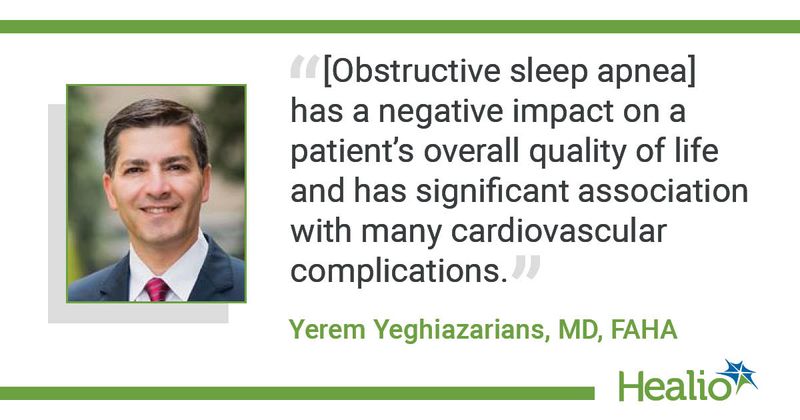AHA: Obstructive sleep apnea common in CVD, more awareness needed
Obstructive sleep apnea is common in individuals with CVD and risk factors including high BP, and screening for it in that population is warranted, according to a scientific statement from the American Heart Association.
“The AHA Scientific Statement was prepared to increase awareness amongst physicians and patients about this condition and to encourage more screening and therapy as appropriate,” Yerem Yeghiazarians, MD, FAHA, chair of the scientific statement writing group and professor of medicine and Leone-Perkins Family Endowed chair in cardiology at the University of California, San Francisco, told Healio. “Treatment of sleep apnea has been associated with improved mood, less snoring, improved quality of life, less daytime sleepiness and increased work productivity.”

According to the statement, published in Circulation, in the U.S., prevalence of obstructive sleep apnea (OSA) is as high as 40% to 80% among individuals with CVD, including hypertension, HF, CAD, pulmonary hypertension, AF and stroke. In addition, OSA also affects 30% to 50% of individuals with high BP; is associated with type 2 diabetes, worse outcomes from HF and sudden cardiac death; and is a risk factor for AF. In addition, OSA is also associated with increased all-cause and CV mortality. Previous studies have found that treatment with continuous positive airway pressure was associated with a 42% reduced mortality rate among those with severe OSA after 6 to 7 years of follow-up.
However, OSA is underrecognized and undertreated despite its high comorbid prevalence with CVD and its increase in adverse CV outcomes, Yeghiazarians and colleagues wrote.
“This condition has a negative impact on a patient’s overall quality of life and has significant association with many cardiovascular complications,” Yeghiazarians told Healio. “Appropriate screening and treatment are recommended.”
In order to combat the lack of diagnosis and treatment of OSA among patients with CVD, the authors recommended the following:
- OSA screening should be conducted in individuals with resistant or poorly controlled hypertension, pulmonary hypertension and recurrent AF after cardioversion or ablation;
- OSA screening through sleep study should be conducted for patients with NYHA class II to IV HF, especially if sleep-disordered breathing or excessive daytime sleepiness is suspected;
- OSA should be treated with therapies available, potentially with lifestyle and behavior modifications and weight loss;
- Severe OSA should be treated with CPAP when possible;
- Patients with mild to moderate OSA may be considered for treatment with oral appliances adjusting jaw and tongue placement during sleep to avoid obstructed breathing; and
- Routine follow-up that includes overnight sleep testing to affirm treatment effectiveness should be conducted.
“Improvements in home diagnostic tools and more research on ways to identify cardiovascular risk in people with OSA are needed,” Yeghiazarians said in a press release. “Still, the overall message is clear: We need to increase awareness about screening for and treating OSA, especially in patients with existing cardiovascular risk factors.”
For more information:
- Yerem Yeghiazarians, MD, FAHA, can be reached at 535 Mission Bay Blvd., South San Francisco, CA 94158.
